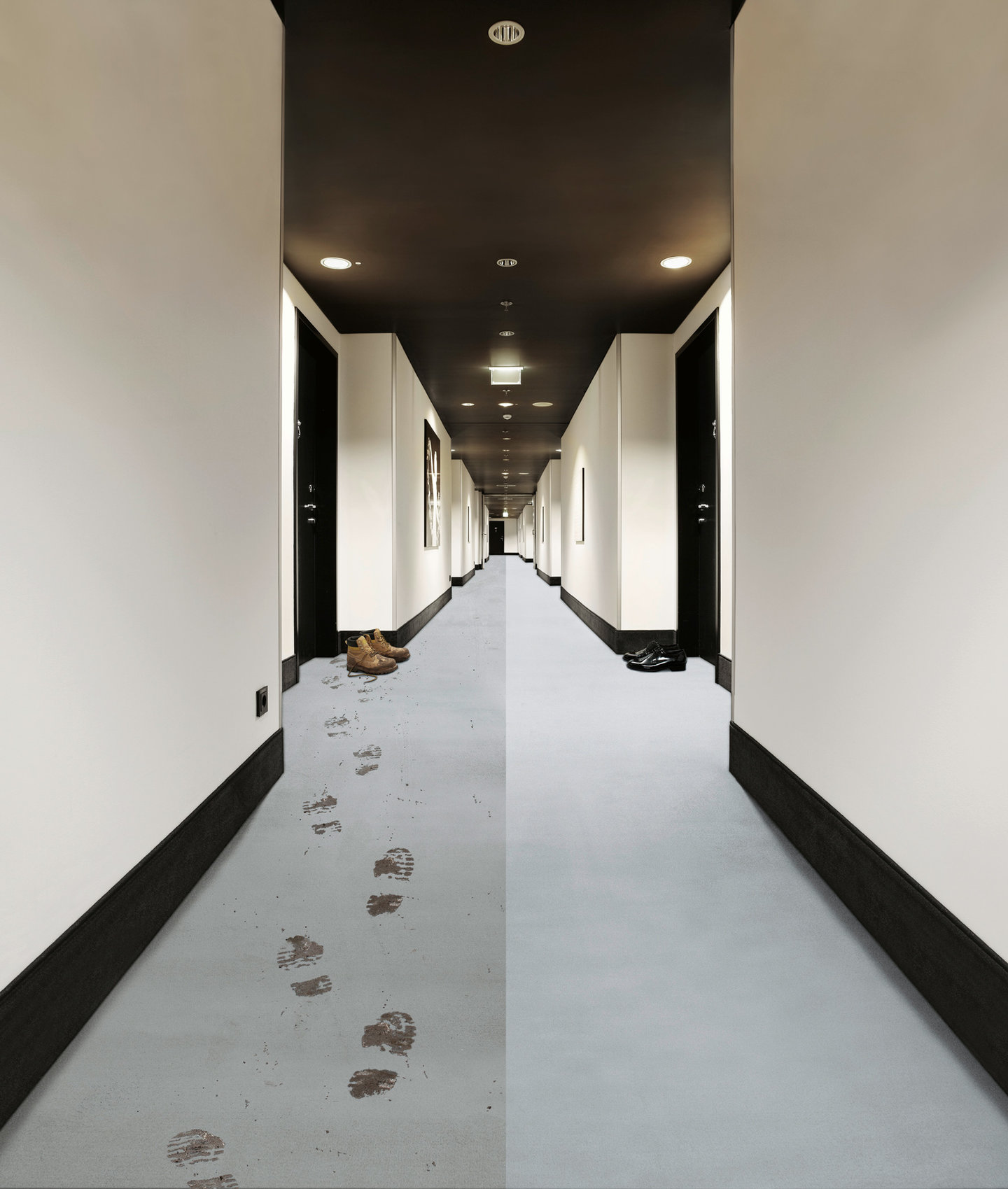About Us
The name Kärcher is a synonym for high performance, quality and innovation worldwide.
For cleaning expertise that sets standards. For the hotel and hospitality industry, the Kärcher system offers outstanding solutions for all requirements: perfectly balanced machines, accessories and cleaning agents.
Top-performing, efficient and economical thanks to innovative technology, low consumption and durability. Inconspicuous and stylish in classic anthracite. Whisper-quiet.
The first impression counts. This is especially true in the hotel and restaurant business. Cleanliness is the first impression guests have of a hotel. Leading hotels and service providers rely on the world market leader Kärcher for this.
From scrubber driers for the foyer to incredibly quiet vacuums for the lobby, Kärcher always has the right cleaning system.
cleaning solutions
Upright brush-type vacuum cleaners like the CV 38/2 combine suction volume with the power of an electrically driven brush. This has the effect of raising the pile to allow the vacuum cleaner to remove dirt particles deep in the pile. The indicator light shows the operator when the roller brush setting should be changed to obtain the best cleaning results.
It’s never been easier and more enjoyable to clean your carpets! Designed to be the ultimate in manoeuvrability and productivity, the BRC 40/22 is driving innovation forward. Enjoy the superior ergonomics of extracting while walking forward. The extractor deck rotates to allow cleaning in any direction. This new carpet cleaner provides between 30 - 60% productivity improvement in addition to reduced drying times. Our cleaning technology provides productive interim & deep carpet cleaning all in one machine.
The A-rated T 12/1 eco!efficiency tub vacuum provides superb daily cleaning performance from its super-quiet 750W motor. As well as low noise and low running costs, the T 12 features a host of user benefits including 5-stage filtration, HEPA option, replaceable kettle-type plug-in power cable, and convenient on-board storage for the cable and accessories.
The SG 4/4 provides thorough, deep and hygienic cleaning without the use of detergents. With steam pressure of 4 bar and a 4 litre tank, the SG 4/4 is highly effective and productive. It is ideal for use in a variety of environments, where fast, hygienic cleaning is a necessity. The SG 4/4 is very simple to use, heats up quickly and can be used continuously thanks to its two-tank system. With a wide range of accessories, the machine is equally suited to detail work around kitchen appliances and bathroom fittings as it is to cleaning floors and walls.
Due to the compact design, the battery-operated on-site scrubber is very agile and also achieves the widest-angled inner surfaces. Thanks to the eco! Efficiency level, water / energy consumption and noise can be significantly reduced. The machine is equipped with 2 roller brushes (90 cm working width). The brush speed can be adjusted as required by means of the FACT function. Color coding of the controls and EASY operation switches make handling considerably easier. All settings are accessible via the large color display. To improve the protection against malfunctions, the KIK system allows access rights to be granted. Hygienic and easy cleaning of the wastewater tank is possible thanks to the optionally available tank flushing system. The optional Auto-Fill feature also facilitates simple and time-saving filling of the fresh water tank. Loading device available as an option. (Configuration example, further equipment variants available).
Cleaning smarter with PDIR
The cleaning process that changes the game
The PDIR Process is born out of years of industry research into how soils accumulate inside of a building and the best practices for managing them. An effective cleaning program begins with an understanding of how soils are brought into the facility, their effect on the surfaces and inhabitants of the facility, and how to best utilize your resources in a strategic fashion to manage them. The PDIR program is focused on creating a clean, healthy environment for the people who live, work, heal, and study in your facility. By following the PDIR Process, you should be able to meet this goal and potentially find additional capacity to clean.
What does PDIR stand for?

P
Preventative maintenance
Stopping the soil before it enters your facility.
■ Process: If we could keep all soil outdoors, we would need little cleaning indoors. Implement a program of sweeping, entrance cleaning and matting systems. Sweep and pressure wash your sidewalks and entryways. Be sure to use entry matting systems large enough to perform the job. Studies have shown that implementing this process can reduce the amount of soil tracked into your facility by 66%.
■ Equipment: Sweepers, pressure washers, and proper exterior and interior matting.
■ Detergents: Preventative maintenance is very green, using little or no detergents.
KM 70/20
D
Daily maintenance
Quickly removing the soil in your facility to minimize damage.
■ Process: By removing soils on a daily basis, you extend the life of your floors. Maintaining carpet and hard floor surfaces daily extends their useful life by removing the dirt quickly once it's in your facility, utilizing vacuuming, carpet spotting, scrubbing, and touchless restroom cleaning.
■ Equipment: Upright and wide area carpet vacuum cleaners, scrubber driers, spot cleaning equipment, stand-on equipment and touchless restroom cleaners.
■ Detergents: No detergents are used for vacuuming. For scrubbing, use neutral floor cleaning agents. For carpet spotting, use special carpet cleaning detergents - watch out for the "wool safe" label.
CV 38/2
I
Interim maintenance
Maintaining the appearance of your floors with little resources use.
■ Process: Maintaining a consistent and high appearance level with interim cleaning reduces the need for and frequency of restorative cleaning. Use encapsulation cleaning and spotting to restore your carpets back to a "like new" appearance and be open for traffic in as few as 20 minutes. For hard floors, burnishing is the first step in interim maintenance, followed by a periodic top-scrub and recoat to brighten your floors with less time, labor and detergent. When recoating your hard floors, choose an environmentally friendly floor finish.
■ Equipment: Use encapsulation machines for interim carpet maintenance and scrubber-driers and burnishers for hard floor surfaces.
■ Detergents: Encapsulation Carpet Cleaner, Carpet Spotter (wool safe), Floor Finishing Agents
BRS 43/500
R
Restorative maintenance
For when the occasion arises for floors to be returned to their “like new” appearance.
■ Process: Restoring the flooring as close as possible to its original appearance through spray extraction in combination with carpet roller brushes on carpets (deep carpet cleaning) and stripping and finishing on hard floor surfaces.
Regardless of the process you implement for your floor care, there will come a time when you will need to execute restorative work. Only restorative cleaning will bring your floors back to a true “like new” state.
■ Equipment: Use scrubber driers and polishers for hard floors. For carpet extraction, utilize either spray-extraction machines or the deep carpet cleaning machine range.
■ Detergents: Floor Stripper and Finish, Carpet Detergents, preferably wool safe.
BRC 40/22
PDIR is a more strategic approach to cleaning, a process to help you rethink your cleaning program as a guideline, to be more environmentally friendly at the same time. The outcome of this process is to help you focus on the most effective and cost-efficient cleaning procedures to get the most bang for your buck. Implementing this program in your hotel will improve its appearance and should allow you to extend the life of your flooring.
A study performed by ISSA* shows:
■ Up to 94% of the soil in a hotel come in with foot traffic
■ After 20 days, 1000 people per day can track in 11kg of soil
■ Soil abrades the surface with the effect of 120 grit sandpaper
■ Soil abrades the surface with the effect of 120 grit sandpaper
■ As few as 1500 people walking across a finished floor can remove 42% of the finish
* The Worldwide Cleaning Industry Association www.issa.com





















